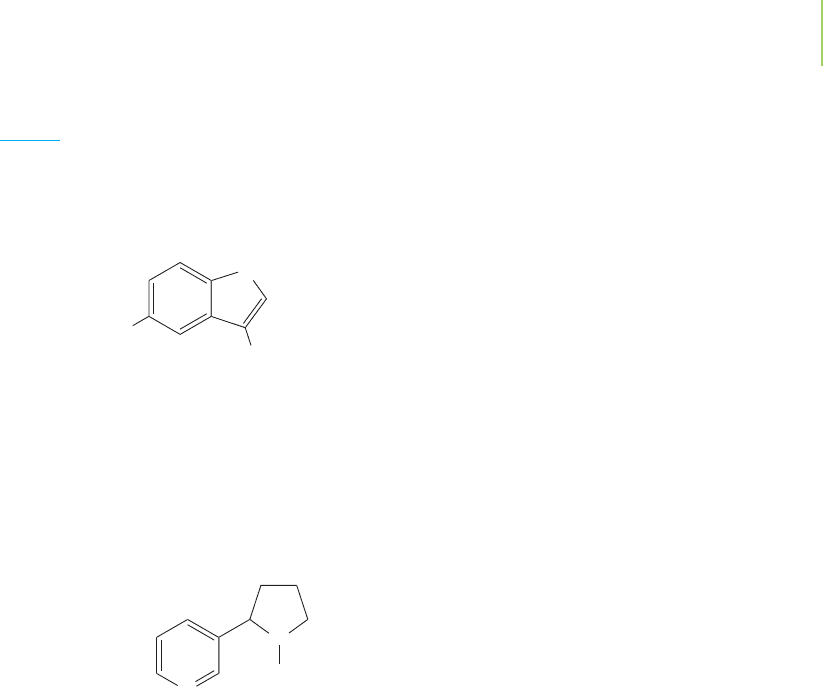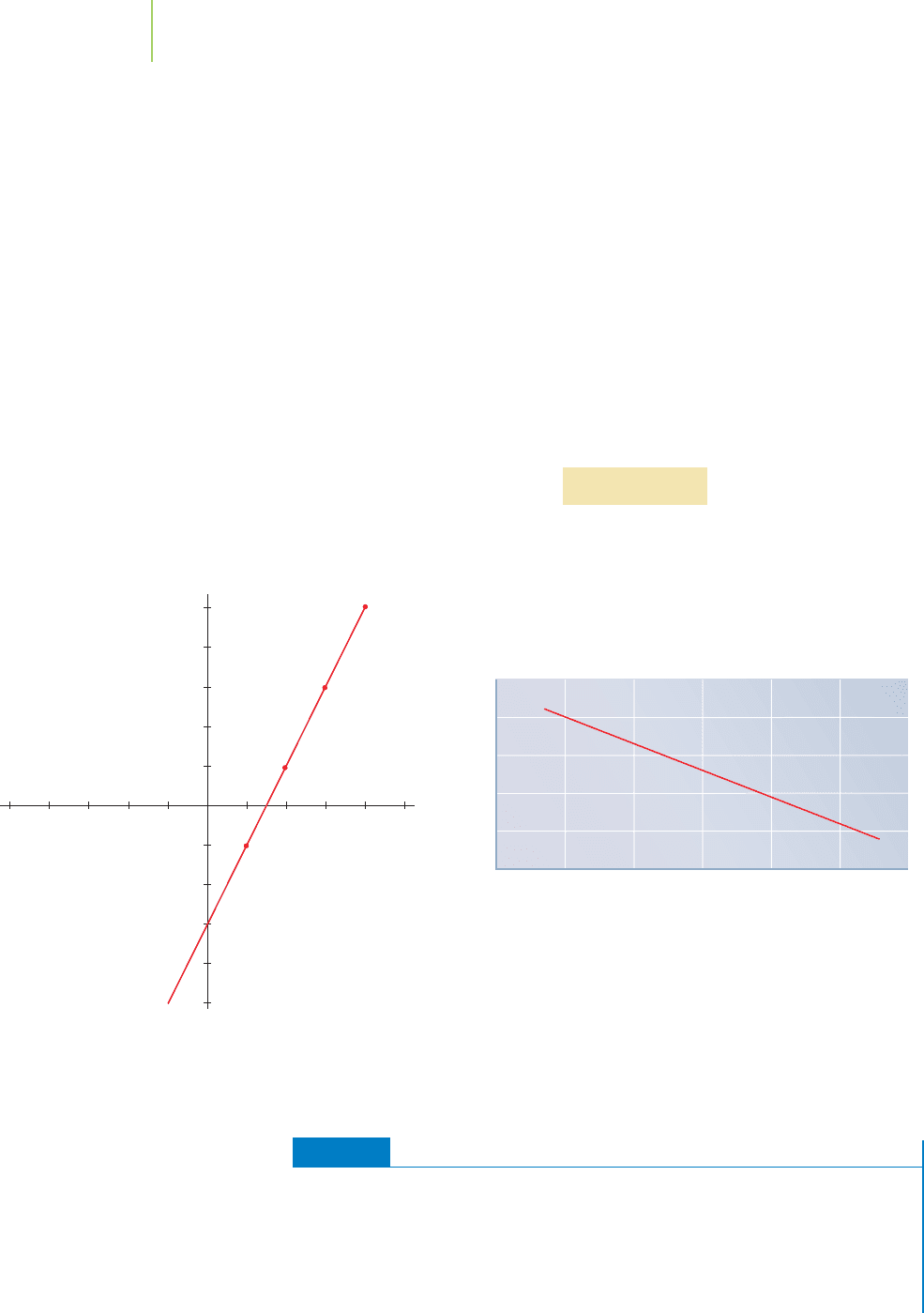Kelter P., Mosher M., Scott A. Chemistry. The Practical Science
Подождите немного. Документ загружается.


Section 22.6 Carbohydrates
Skill Review
23. Identify of the following carbohydrate as either a triose, a
tetrose, a pentose, or a hexose.
24. Identify the following carbohydrate as either a triose, a
tetrose, a pentose, or a hexose.
25. Identify the carbohydrate in Problem 23 as either an aldose
or a ketose.
26. Identify the carbohydrate in Problem 24 as either an aldose
or a ketose.
27. Which simple carbohydrate do starch, glycogen, and cellu-
lose have in common?
28. A very serious malady exists in humans who lack the enzyme
responsible for hydrolyzing glycogen. Explain why this deficit
would be harmful to health.
Chemical Applications and Practices
29. High-fructose corn syrup is a common ingredient in some
fruit drinks. What is the most likely source of this fructose?
Identify fructose as either a triose, a tetrose, a pentose, or a
hexose. Identify fructose as an aldose or a ketose.
30. Maltose, shown below, is a disaccharide. Which two simple
carbohydrates condense to make maltose?
Section 22.7 Lipids
Skill Review
31. Explain the distinction between fats and oils.
32. A company wishes to manufacture margarine using veg-
etable oil. Explain how this is done.
33. Would you expect the triacylglycerol shown below to be a
component of a fat or of an oil?
O
O
O
O
O
O
H
O
H
O
O
OH
H
OH
CH
2
OH
H
H
H
O
CH
2
OH
H
OH
H
H
H
OH
H
OH
OH
CH
2
OH
C
OH
H
C
OH
HOCH
2
C C
H
OH
CHO
CC
OH
OH
H
HOCH
2
H
968 Chapter 22 The Chemistry of Life
34. Would you expect the triacylglycerol shown below to be a
component of a fat or of an oil?
Chemical Applications and Practices
35. Triacylglycerols and phospholipids make up the cell mem-
branes in living organisms. Which end of these molecules
would you predict to associate closely with the outside of the
cell (in contact with water)?
36. The interior of a cell is known as the cytoplasm. It contains
many different types of molecules, but the bulk of the mole-
cules are water. Explain how a cell membrane could be made
from phospholipids if the exterior and interior of a cell are
both made up of water molecules.
Section 22.9 Biochemistry and Chirality
Skill Review
37. Draw both enantiomers of serine and of phenylalanine.
38. Draw both enantiomers of glucose as a straight-chained mol-
ecule and as a cyclic monosaccharide.
39. What are the advantages of an enzyme’s possessing a chiral
active site?
40. If every enzyme possesses a chiral active site, why do both
enantiomers of thalidomide exhibit biological activity?
O
O
O
O
O
O
P
OH
NH
OH
O
O
O
O
OH
N
O
O
O
O
O
O
O

Chemical Applications and Practices
41. Serotonin is a neurotransmitter involved in sleep, sensory
perception, and the regulation of body temperature. From
which amino acid is it probably likely manufactured in the
body? Does serotonin have an enantiomer?
42. Nicotine is a common stimulant. In doses greater than
50 mg, it can be lethal to humans. Nicotine is excreted via
urine by protonation, at which point the resulting cation is
very soluble in water. Eating a meal causes the pH of urine to
drop.
a. Identify the chrial center in nicotine.
b. Why would you predict that a smoker would crave a
cigarette immediately after a meal?
Comprehensive Problems
43. Indicate the mRNA and protein that would result from the
transcription and translation of this DNA sequence.
TACAGCGCTTAAATTCCGACGAATAA
44. What sequence of the gene would produce this polypeptide?
gly-lys-glu-arg-lys-trp-trp
N
N
CH
3
H
N
H
O
CH
2
CH
2
NH
2
45. Explain why the melting points (shown in Table 22.3) in-
crease from lauric acid, to myristic acid, to palmitic acid, to
stearic acid.
46. Explain why the melting point of oleic acid is less than the
melting point of stearic acid.
47. Would you predict the enantiomer of the compound we call
table sugar to be sweet? Explain
48. Termites consume wood as food. What polysaccharide is pre-
sent in wood? Knowing this, and knowing that termites lack
the enzyme that can digest that particular polysaccharide,
suggest what must be present within the termite’s stomach in
order for it to derive energy from its food.
Thinking Beyond the Calculation
49. Chocolate-covered cherries are made by coating a cherry
with a paste of sucrose and the enzyme invertase. The cher-
ries are stored after they are treated until the enzyme has had
a chance to partially hydrolyze the sucrose. The resulting
syrup is called invert sugar.
a. Draw the reaction of sucrose and invertase.
b. On the basis of your understanding of enzymes, would
you predict that maltose would undergo a similar reaction
with invertase.
c. Genetic modification of invertase places an extra lysine in
the protein. What codon and anticodon could produce
this modification?
d. A researcher wishes to manufacture 10.0 kg of invert sugar
from sucrose. How many grams of sucrose would be
required to accomplish this feat?
e. If the same researcher were able to separate all of the
glucose from the invert sugar, how many grams of fructose
could be made from 15.5 kg of sucrose?
f. The same researcher is interested in finding a hydrolase
that will accept cellulose as the substrate. What benefit
would this have to humans?
Focus Your Learning
969
This page intentionally left blank

In this discussion, we work with four mathematical tools that are essential parts
of the chemist’s toolbox: exponents, logarithms, the quadratic equation, and
graphing linear functions. This is not intended to be a complete treatment.
Rather, it is an introduction upon which you can build as you study chemistry.
A1.1 Working with Exponents
Numbers tell us how much we have. In chemistry, the numbers can be remark-
ably small, as in the mass of a single sodium atom (0.000 000 000 000 000 000 000
04 gram). They can also be very large, as in the total number of atoms of the uni-
verse. For instance, the number of atoms in the universe is estimated by the
National Solar Observatory at Sacramento Peak to be, perhaps, 10 000 000 000
000 000 000 000 000 000 000 000 000 000 000 000 000 000 000 000 000 000 000
000 000 000 000 atoms.
These numbers are unwieldy to work with, so we convert them into exponen-
tial notation, a way of expressing numbers that uses the powers of 10. The key to
exponential notation is to know what happens when we multiply 10 by itself
any number of times. For example, when we multiply 10 by itself 3 times, what
do we get?
10 × 10 × 10 = 1000
When we use exponential notation, we put the number of times we multiply
10 by itself as a superscript immediately after the 10. That is,
10 × 10 × 10 = 10
3
= 1000
We can expand this list indefinitely:
10 10
1
= 10
10
× 10 10
2
= 100
10
× 10 × 10 10
3
= 1000
10
× 10 × 10 × 10 10
4
= 10000
10
× 10 × 10 × 10 ×10 × 10 × 10 × 10 10
8
= 100000000
and so on
Appendixes A1
Appendix 1: Mathematical Operations
Appendix 2: Calculating Uncertainties in Measurements
Appendix 3: Thermodynamic Data for Selected Compounds at 298 K
Appendix 4: Colligative Property Constants for Selected Compounds
Appendix 5: Selected Equilibrium Constants at 298 K
Appendix 6: Water Vapor Pressure Table
Appendix 7: Standard Reduction Potentials at 298 K
Appendix 8: Common Radioactive Nuclei
Appendixes
Appendix 1
Mathematical Operations
A1

Note that the number of zeros after the 1 is equal to the number of the super-
script, which is called the power of 10. The number 10,000 is equal to 10
4
,or,in
words, “ten to the fourth power.”
What would our number of atoms in the universe look like in scientific
notation?
10 000 000 000 000 000 000 000 000 000 000 000 000 000 000 000 000 000 000 000
000 000 000 000 000 000 000 atoms =10
79
atoms,or“ten to the 79th power”atoms
What if we have a number such as 60,000? We can split this into two numbers
in such a way that one of the numbers is a power of 10. Thus 60,000 becomes
6 × 10,000. This is the same as 6 × 10
4
. The number 6 is known as a pre-
exponential. Using the pre-exponential and the exponential terms, we can express
the number 823,000,000 in exponential notation as 8.23 ×10
8
. It may also be
expressed as
82.3 × 10
7
823 × 10
6
or even 8230 × 10
5
(8230 × 100,000), although that is fairly awkward. In each
case, however, we have reduced the exponent by 1 (a power of 10) as we increased
the pre-exponential term by a factor of 10. The number remains the same—
823,000,000—in each case.
We can also go from the large to the small:
110
0
= 1
1/10 10
−1
= 0.1
1/(10 × 10) 10
−2
= 0.01
1/(10 × 10 × 10) 10
−3
= 0.001
1/(10 × 10 × 10 × 10) 10
−4
= 0.0001
1/(10 × 10 × 10 × 10 × 10 × 10 × 10 × 10) 10
−8
= 0.00000001
and so on
We note that the number of zeros after the decimal point is equal to the negative
subscript minus 1. There are seven zeros after the decimal point in 10
−8
.
Addition and Subtraction
If we wish to add or subtract numbers that are in exponential notation without
using an electronic calculator, the numbers must be raised to the same power of
10. We can achieve this prior to the addition or calculation by moving the deci-
mal place as appropriate. For example,
(3.11 ×10
4
) + (2.07 ×10
5
) = (3.11 ×10
4
) + (20.7 ×10
4
) = 23.8 ×10
4
= 2.38 ×10
5
(3.11 ×10
4
) – (9.50 ×10
3
) = (31.1 ×10
3
) – (9.50 ×10
3
) = 21.6 ×10
3
= 2.16 ×10
4
If we are using a calculator, we can just enter the numbers without any adjust-
ment. We do this with the key labeled EXP or EE on most calculators. For exam-
ple, to enter 3.11
× 10
4
, we key in the following sequence:
To enter a number with a negative exponent, such as 3.11
× 10
−4
, we follow the
sequence
Multiplication and Division
When numbers expressed in exponential notation are to be multiplied, the expo-
nent parts of the numbers must be added together:
4−
EXP
11
.
3
4
EXP
11
.
3
A2 Appendixes

(7.20 × 10
4
) × (2.10 × 10
3
) = (7.20 × 2.10) × 10
3+4
= 15.1 × 10
7
= 1.51 × 10
8
When numbers expressed in exponential notation are to be divided, the exponent
of the denominator is subtracted from the exponent of the numerator:
3.70 × 10
2
/2.20 × 10
3
= (3.70/2.20) × 10
2–3
= 1.68 × 10
–1
PRACTICE
a. Convert 345 000 000 into exponential form. (Ans: 3.45 × 10
8
)
b. Convert 1.43 × 10
−3
into nonexponential form. (Ans: 0.00143)
c. Calculate: (2.56 × 10
2
) + (3.41 × 10
3
) (Ans: 3.67 × 10
3
)
d. Calculate: (7.11 × 10
6
) − (2.50 × 10
5
) (Ans: 6.86 ×10
6
)
e. Calculate: (8.26 × 10
2
) × (1.70 × 10
4
) (Ans: 1.40 ×10
7
)
f. Calculate: (6.32 × 10
7
)/(7.70 × 10
4
) (Ans: 8.21 × 10
2
)
A1.2 Working with Logarithms
Logarithms to the Base 10
As we saw in the previous section, we can use exponential notation to indicate the
conversion of 10 into 1000 by raising 10 to the third power:
10
3
= 1000
Here 3 is referred to as the logarithm of 1000 to the base 10, because it is the
exponent of the base number 10 that is needed to raise 10 to equal 1000. We can
indicate this by writing log
10
1000 = 3, which is read, “the logarithm to the base
10 of the number 1000 is 3.”
Logarithms to the base 10 are known as common logarithms, and use of the
base 10 is so common that it is not always explicitly stated. When you see a refer-
ence to the logarithm, or log, of a number without the base being specified, you
should assume the base is 10.
Logarithms can be negative as well as positive. Here are some other examples:
logarithm of 10 000 to base 10 = 4log
10
10 000 = 4
logarithm of 100 to base 10 = 2log
10
100 = 2
logarithm of 1 to base 10 = 0 (because 10
0
= 1) log
10
1 = 0
logarithm of 0.01 to base 10 =
−2log
10
0.01 = −2
logarithm of 0.0001 to base 10 =
−4log
10
0.0001 = −4
Most numbers are not the simple multiples of 10 used in our examples above.
For more awkward numbers, such as 73.5, we use the LOG key on a calculator to
find the value of the logarithm to the base 10. Get a scientific calculator, press the
LOG key, and then enter 73.5 followed by the equals key. You will find that
log
10
73.5 = 1.866
which tells us that 10
1.866
= 73.5.
This answer makes sense, because 73.5 is between 10 (which has a logarithm
of 1, because 10
1
= 10) and 100 (which has a logarithm of 2, because 10
2
= 100).
Accordingly, we expect the logarithm of 73.5 to be between 1 and 2 and to be
closer to 2 than to 1. Because the integers to the left of the decimal in a logarithm
only set the location of the decimal point, the number of digits after the decimal
point in the logarithm should equal the number of significant figures in the orig-
inal number. Hence the logarithm 1.866 only has three significant figures.
Appendix 1 Mathematical Operations A3

Now let’s consider working in the opposite direction. Finding the number
that corresponds to a given logarithm is known as obtaining an antilogarithm (or
antilog). The calculator will do this for us when we either use the 10
x
key or press
the inverse function key (labeled INV or SHIFT) followed by the LOG key.
Determine which method your calculator uses, and then confirm that
antilog 2 = 100
antilog 1.866 = 73.5
Natural Logarithms
The mathematical equations that describe the behavior of many natural phe-
nomena frequently involve the constant e, which has a value of 2.71828....Log-
arithms that have the number e as the base are referred to as natural logarithms.
The natural logarithm (or natural log) of a number is the power to which e must
be raised to equal that number. The natural logarithm is often symbolized ln to
distinguish it from the log or log
10
used for logarithms to the base 10.
You can use the LN key of your calculator to find the natural logarithm of any
number. For example,
ln 10.0 = 2.303 because e
2.303
= 10
ln 73.5 = 4.297 because e
4.297
= 73.5
Natural antilogarithms can be obtained by either using the e
x
key or pressing the
inverse function key followed by the LN key. Use whichever system your calcula-
tor employs to confirm that
natural antilogarithm of 2.303 = 10
natural antilogarithm of 4.297 = 73.5
Mathematical Operations with Logarithms
The logarithm of a product equals the sum of the logarithms of the individual
numbers being multiplied. This follows from the fact that logarithms are expo-
nents, which we looked at in the previous section.
logarithm(a × b) = logarithm a + logarithm b
By the same logic, the logarithm of the result of dividing a number by another
is obtained by subtracting the logarithm of the denominator from that of the
numerator:
log(a/b) = log a − log b
And if we wish to raise a logarithm to a certain power, we use the following rules:
log(a
n
) = n log a
log(a
1/n
) = (1/n) log a
These rules apply no matter what base is used.
PRACTICE
Use your calculator to find the numerical answer to the following operations.
a. log
10
55.2 (Ans: 1.742)
b. ln 27.6 (Ans: 3.318)
c. antilog 1.522 (Ans: 33.3)
d. natural antilog 3.233 (Ans: 25.4)
A4 Appendixes

A1.3 Solving the Quadratic Equation
A quadratic equation has the variable raised to the second power, and no higher.
It has the general form
ax
2
+ bx + c = 0
In this textbook, we use quadratic equations to solve some problems related
to chemical equilibrium, including acid–base chemistry, solubility chemistry, and
complex-ion chemistry (Chapters 16–18).
Although there are several ways to solve quadratic equations, we will use the
quadratic formula in this text. The formula will always yield two answers (because
second-order polynomial equations describe a parabola that has two y-axis val-
ues for every x-axis value), yet only one of these answers will be chemically rea-
sonable. Whenever we use the quadratic equation, we will explain how you will
know which of the two answers is reasonable. The quadratic formula is used to
solve for the variable x and has the form
x =
−b ±
√
b
2
− 4ac
2a
where the constants a, b, and c are the numbers in the quadratic equation when it
is written in general form.
For example, if we are solving the following equation, we need to determine
the values of a, b, and c in order to use the quadratic formula.
x
2
+ 0.0500x − 0.0300 = 0
ax
2
+ bx + c = 0
Comparing this to the general form for a quadratic equation reveals that the val-
ues for the constants a, b, and c are
a = 1; b = +0.0500; c = −0.0300
Next, we insert our values for a, b, and c into the equadratic equation and solve.
We obtain two values for x:
x =
−b ±
√
b
2
− 4ac
2a
x =
−0.0500 ±
(0.0500)
2
− 4(1)(−0.0300)
2(1)
x =
−0.0500 ±
√
0.00250 +0.120
2(1)
x =
−0.0500 ±0.350
2(1)
x = 0.150, –0.200
Just remember: Although we get two answers when we solve the quadratic equa-
tion, we will find in our chemistry work that only one of them will be chemically
valid.
PRACTICE
What is the value of x in this quadratic equation?
x
2
+ 0.0505x – 0.0435 = 0 (Ans: +0.184, –0.235)
Appendix 1 Mathematical Operations A5

80
85
90
95
100
105
–1000
–5
–4
–3
–2
–1
1
2
3
4
5
0
0
5
x
y
4
y = mx + b
321–1–2–3–4–5
1000 2000 3000 4000 5000
Altitude (meters)
Boiling point of water (˚C)
A1.4 Graphing
In your study of chemistry and other aspects of science, you will frequently need
to interpret or draw graphs that show the relationship between variables. For any
value of one variable, the graph shows the corresponding value of the other vari-
able. The variable whose value we monitor rather than control during an experi-
ment is called the dependent variable and is usually displayed along the vertical
axis, which is called the y-axis. The other variable, which we may be purposely
varying during the course of an experiment, is called the independent variable
and is displayed along the horizontal axis, which is called the x-axis. If we are
monitoring the production of some chemical product with time, for example, the
increasing concentration of the product would be plotted on the vertical y-axis,
and time would be plotted on the horizontal x-axis.
Graphs can be linear (consisting of straight lines), can be made up of curves,
or can consist of mixtures of linear and curved portions. Any straight-line graph
is described by the general equation
y = mx + b
where m is the slope of the line and b is the value at the intercept of the line with
the y-axis.
Consider, for example, the two graphs above. The one on the left illustrates
the general principles, and on the right we show a real-world example. In the
graph on the left, we can calculate the slope m as (y
2
– y
1
)/(x
2
– x
1
) = 4/2 = 2. And
we can see that the intercept occurs at –3 on the y-axis. Therefore, the equation of
the straight line is y = 2x − 3.
PRACTICE
The real world is rarely as neat and tidy as general principles. Calculate the equation
of the straight line in the real-world example on the right, above. Note that in this
case the slope has a negative value, and the x-axis does not cut across the y-axis at
the zero level. These are both features you may encounter in graphs, but the equa-
tion can be readily calculated by using the method illustrated in the example above.
(Ans: y = –0.0033x + 100)
A6 Appendixes

Appendix 2 Calculating Uncertainties in Measurements A7
Appendix 2
Calculating Uncertainties in Measurements
Error in measurements is an obstinate inevitability that all scientists (and every-
one else, for that matter) must contend with. When we measure the distance to
the store, or the mass of a raisin, we encounter a certain amount of variability. As
we learned in Chapter 1, this variability is due not only to random error but also
to systematic error. Even during the perfect measurement, where the systematic
error is negligible, our measurement still contains some random error. Therefore,
when scientists report a measurement, they make sure to include a statement
about the level of confidence that they place in that number.
The statement of how precise a set of measurements are can be reported as
the standard deviation(s) of the measurements. The mathematical definition of
standard deviation is
s =
n
i=1
(x
i
−¯x)
2
n − 1
where x
i
= each individual measurement
¯x =
the mean (average) of the measurements
n = number of measurements taken
The equation indicates that we take the difference between each measurement
and the mean, square it, and then add all these results together. The total is then
divided by one less than the total number of measurements, and the square root
of the result is taken.
The standard deviation can be used to determine how well the measurements
agree with the literature value. This is typically established by calculating a confi-
dence limit or a confidence interval. The confidence limit (C.L.) consists of a range
of numbers that describes the precision of our set of measurements. The confi-
dence interval (C.I.) describes the mean value and the confidence limit employed
to generate a range of numbers surrounding the mean value of our measure-
ments. This number is called a confidence interval because we have a great deal of
confidence that the actual number lies within this range. As we increase our con-
fidence in the measurement, the confidence limit increases in size. Conversely,
as the confidence limit decreases in size with a set confidence level, our precision
increases.
C.L. =
ts
√
n
C.I. =¯x ±
ts
√
n
where t is a measure of the confidence we place in the measurement.
The levels of confidence that are most commonly used in determining a con-
fidence interval are the 90% and 95% levels.A 90% level of confidence means that
in 10% of cases, the accepted value will lie outside our confidence interval. A 95%
level of confidence indicates that the accepted value will lie outside our interval
in only 5% of cases. For example, say an experiment produces three measure-
ments such that the mean is 2.31 and the standard deviation is 0.48. The value of
